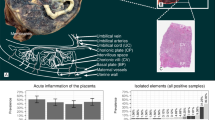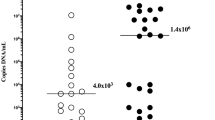Abstract
Ascending amniotic fluid bacterial infection is a cause of perinatal morbidity and mortality. A diagnosis of amniotic cavity infection can be inferred by documenting maternal (acute chorioamnionitis) and/or fetal (chorionic plate vasculitis; umbilical vasculitis/funisitis) inflammatory response. A definitive diagnosis of intrauterine/neonatal sepsis as a cause of stillbirth requires positive blood cultures obtained at postmortem examination. However, if postmortem examination is not performed, acute chorioamnionitis with/without fetal inflammatory response cannot be classified as a cause of demise. We present a case of intrauterine demise associated with acute chorioamnionitis, villitis, and intervillositis of the placenta. Although postmortem examination was denied, a conclusive diagnosis of intrauterine sepsis could be rendered by demonstration of gram-positive cocci within fetal vessels of umbilical cord, chorionic plate, and stem villi. This report highlights the importance of identification of placental intravascular organisms as unequivocal evidence of fetal sepsis, especially in cases where cultures cannot be obtained.
This is a preview of subscription content, access via your institution
Access options
Subscribe to this journal
Receive 12 print issues and online access
$259.00 per year
only $21.58 per issue
Buy this article
- Purchase on Springer Link
- Instant access to full article PDF
Prices may be subject to local taxes which are calculated during checkout


Similar content being viewed by others
References
Hood IC, Desa DJ, Whyte RK . The inflammatory response in candidal chorioamnionitis. Hum Pathol 1983; 14: 984–990.
Regan JA, Klebanoff MA, Nugent RP . The epidemiology of group B streptococcal colonization in pregnancy. Vaginal Infections and Prematurity Study Group. Obstet Gynecol 1991; 77: 604–610.
Vigorita VJ, Parmley TH . Intramembranous localization of bacteria in beta-hemolytic group B streptococcal chorioamnionitis. Obstet Gynecol 1979; 53: 13S–15S.
Kraus FT, Redline RW, Gersell DJ, Nelson DM, Dicke JM . Inflammation and infection. Placental pathology. In: Donald WK (ed). Atlas of Nontumoral Pathology. American Registry of Pathology Armed Forces Institute of Pathology: Washington, DC, 2004. pp 90–91.
Bhola K, Al-Kindi H, Fadia M, Kent AL, Collignon P, Dahlstrom JE . Placental cultures in the era of peripartum antibiotic use. Aust N Z J Obstet Gynaecol 2008; 48: 179–184.
Newton ER, Clark M . Group B streptococcus and preterm rupture of membranes. Obstet Gynecol 1988; 71: 198–202.
De Paepe ME, Friedman RM, Gundogan F, Pinar H, Oyer CE . The histologic fetoplacental inflammatory response in fatal perinatal group B-streptococcus infection. J Perinatol 2004; 24: 441–445.
Author information
Authors and Affiliations
Corresponding author
Ethics declarations
Competing interests
The authors declare no conflict of interest.
Rights and permissions
About this article
Cite this article
Matoso, A., Shapiro, S., De Paepe, M. et al. Placental intravascular organisms: a case report. J Perinatol 30, 688–690 (2010). https://doi.org/10.1038/jp.2010.63
Received:
Revised:
Accepted:
Published:
Issue Date:
DOI: https://doi.org/10.1038/jp.2010.63



